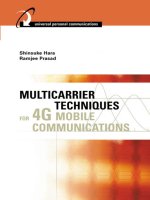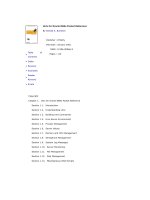Tài liệu Multicarrier Techniques for 4G Mobile Communications P doc
Bạn đang xem bản rút gọn của tài liệu. Xem và tải ngay bản đầy đủ của tài liệu tại đây (221.49 KB, 10 trang )
22 Multicarrier Techniques for 4G Mobile Communications
2.7 Examples of Multipath Fading Channels
As discussed, when a signal is transmitted through a multipath fading channel,
a channel model, which we assume, gives its received characteristics. For
instance, the p.d.f. such as Rayleigh distribution and Ricean distribution
describes the envelope fluctuation for an individual multipath component
in the channel, the multipath intensity profile or spaced-frequency correlation
function determines the frequency selectivity of the channel, and the Doppler
power spectrum or spaced-time correlation function determines the time
selectivity of the channel.
Figure 2.5 shows examples of multipath delay profiles to describe
frequency selectivity of a channel, which we often use in this book for
computer simulation. Here, we can assume that the fading characteristic of
each path is independent because of WSSUS, and we often assume a Rayleigh
distribution for each envelope and a uniform distribution for each phase.
In Figure 2.5(a), there are a fixed number of paths with equidistant delays
and the average received powers of multipaths are exponentially decaying.
We often encounter this kind of profile in indoor environments [9, 10] and
we call it ‘‘an exponentially decaying profile.’’ On the other hand, in Figure
2.5(b), there are also a fixed number of paths with equidistant delays but
the average received powers of multipaths are all the same. We often use
this kind of profile to test a system performance [6] and we call it ‘‘an
independent and identically distributed (i.i.d.) profile.’’
The time variation of a channel is determined by a lot of factors, such
as the height of transmitter/receiver antenna, the speed of transmitter/receiver
Figure 2.5 Examples of multipath delay profiles: (a) an exponentially decaying multipath
delay profile; and (b) an i.i.d. multipath delay profile.
TEAMFLY
Team-Fly
®
23
Characteristics of Multipath Fading Channels
in motion, the shape of the antenna, the height of surrounding structures,
and so on.
Figure 2.6 shows a situation where a receiver with an omnidirectional
antenna is in motion with velocity of v and a lot of signals arrive at the
antenna in all directions. This model is called the ‘‘Jakes’ model,’’ [4, 5]
and in this case, defining the direction arrival of a signal from the direction
of motion as
, the Doppler shift for the signal is given by
=
v
cos
= f
D
cos
(2.29)
where
is the wavelength and f
D
is the maximum Doppler shift. Defining
the power spectrum density as D
H
(
), the power of the received signal in
frequency range of [
,
+ d
] is given by
D
H
(
)
|
d
|
= 2 ×
2
r
2
|
d
|
(2.30)
Differentiating (2.28) leads to:
d
=−f
D
sin
d
(2.31)
therefore, finally, substituting (2.31) into (2.30), we obtain the Doppler
power spectrum:
Figure 2.6 Jakes’ model.
24 Multicarrier Techniques for 4G Mobile Communications
D
H
(
) =
2
r
√
f
2
D
−
2
(2.32)
Figure 2.7 shows the Doppler power spectrum. Equation (2.32) means
that the bandwidth of the received signal is broadened; in other words, the
signal is randomly frequency-modulated by noise through the channel. We
call this noise ‘‘random FM noise.’’
Substituting (2.32) into (2.28) leads to:
H
(⌬t) =
2
r
J
0
(2
f
D
⌬t) (2.33)
where J
0
(x)isthezeroth Bessel function of the first kind.
Figure 2.8 shows a time variation of signal through a frequency nonse-
lective Rayleigh fading channel. The envelope and phase (see Figure 2.8(a, b),
respectively) are obtained by computer simulation based on the following
equation [11]:
Figure 2.7 Doppler power spectrum.
25
Characteristics of Multipath Fading Channels
Figure 2.8 Time variation of a signal received through a frequency nonselective Rayleigh
fading channel: (a) envelope; and (b) phase.
r(t) =
∑
L
l
=
1
e
j2
f
D
cos
ͩ
2
l
L
ͪ
t
(2.34)
where we used L = 9 and f
D
= 1 Hz. It is interesting to note that (2.34)
means a sum of deterministic signals with the same amplitude, but because
of the central limit theorem, the envelope and phase of the resultant signal
are Rayleigh and uniformly distributed, respectively.
The three factors to describe the fading characteristics that a transmitted
signal experiences in a channel, such as the p.d.f. of the envelope, frequency
selectivity, and time selectivity, are independent, so there are many combina-
tions to consider. For instance, when no line-of-sight component is available
in a channel, the data transmission rate is very high, and the receiver
is installed in a high-speed cruising vehicle, the channel will be ‘‘a fre-
quency selective fast Rayleigh fading channel,’’ whereas when a line-of-sight
26 Multicarrier Techniques for 4G Mobile Communications
component is available in a channel, the data transmission rate is very low
and the receiver is installed in a stationary terminal, the channel will be ‘‘a
frequency nonselective slow Ricean fading channel.’’
References
[1] Prasad, R., ‘‘European Radio Propagation and Subsystems Research for the Evolution
of Mobile Communications,’’ IEEE Comm. Mag., Vol. 34, No. 2, February 1996,
p. 58.
[2] Prasad, R., Universal Wireless Personal Communications, Norwood, MA: Artech House,
1998.
[3] Schwartz, M., W. R. Bennett, and S. Stein, Communication Systems and Techniques,
New York: IEEE Press, 1996.
[4] Jakes, Jr., C., Microwave Mobile Communications, New York: John Wiley & Sons,
1974.
[5] Lee, W. C. Y., Mobile Communications Engineering, New York: McGraw-Hill, 1982.
[6] Steele, R., Mobile Radio Communications, New York: IEEE Press, 1992.
[7] Rappaport, T. S., Wireless Communications, Piscataway, NJ: Prentice Hall, 1996.
[8] Proakis, J. G., Digital Communications, Fourth Edition, New York: McGraw-Hill,
2001.
[9] Saleh, A. A., and R. A. Valenzuela, ‘‘A Statistical Model for Indoor Multipath Propaga-
tion,’’ IEEE J. Select. Areas Commun., Vol. SAC-5, No. 2, February 1987, pp. 128–137.
[10] Hashemi, H., ‘‘The Indoor Radio Propagation Channel,’’ Proc. IEEE, Vol. 81,
No. 7, July 1993, pp. 943–968.
[11] Cavers, J. K., Mobile Channel Characteristics, Boston, MA: Kluwer Academic Pub-
lishers, 2000.
3
Principle and History of MCM/OFDM
3.1 Introduction
OFDM is a special form of multicarrier modulation (MCM), where a single
data stream is transmitted over a number of lower rate subcarriers. It is
worth mentioning here that OFDM can be seen as either a modulation
technique or a multiplexing technique.
One of the main reasons to use OFDM is to increase the robustness
against frequency selective fading and narrowband interference. In a single
carrier system, a single fade or interferer can cause the entire link to fail,
but in a multicarrier system, only a small percentage of subcarriers will be
affected. Error correction coding can then be used to correct the few erroneous
subcarriers.
An introduction to OFDM is given in [1], and [2] presents the basic
concept of OFDM and its applications. This chapter revisits the principle
of OFDM and its history from its origin to current form. Throughput this
chapter, we discuss the details in equivalent baseband expression.
This chapter is organized as follows. The origin of OFDM is discussed
in Section 3.2, Section 3.3 presents the use of discrete Fourier transform
(DFT), and the insertion of cyclic prefix for OFDM’s current form is
explained in Section 3.4. Section 3.5 concludes the topic.
3.2 Origin of OFDM
MCM is the principle of transmitting data by dividing input stream into
several symbol streams, each of which has a much lower symbol rate, and
by using these substreams to modulate several subcarriers.
27
28 Multicarrier Techniques for 4G Mobile Communications
Figure 3.1 compares a singlecarrier modulation (SCM) and an MCM.
Here, B
SCM
and B
MCM
denote the bandwidths of transmitted SCM and
MCM signals, respectively. For MCM, f
k
, F
k
( f ; t), N
SC
and ⌬ f denote
the frequency of the kth subcarrier, the frequency spectrum of pulse waveform
of the kth subcarrier, the total number of subcarriers, and subcarrier separa-
tion, respectively. The frequency spectrum of the MCM signal is written as
S
MCM
( f ; t) =
∑
N
SC
k
=
1
F
k
( f ; t) (3.1)
Through a frequency selective fading channel characterized by the
transfer function H( f ; t), the frequency spectra of received SCM and MCM
signals are written as
Figure 3.1 Comparison of SCM and MCM: (a) frequency spectra of transmitted signals;
and (b) frequency spectra of received signals.
29
Principle and History of MCM/OFDM
R
SCM
( f ; t) = H ( f ; t)S
SCM
( f ; t)
R
MCM
( f ; t) = H ( f ; t)S
MCM
( f ; t) (3.2)
=
∑
N
SC
k
=
1
H
k
( f ; t)F
k
( f ; t) (3.3)
where S
SCM
( f ; t) is the frequency spectrum of the transmitted SCM
signal and H
k
( f ; t ) is the channel transfer function corresponding to B
k
,
which is the frequency band occupied by the kth subcarrier. When the
number of subcarriers is large, the amplitude and phase response of H
k
( f ; t)
can be assumed to be constant over B
k
,soR
MCM
( f ; t) can be
approximated as
R
MCM
( f ; t) ≅
∑
N
SC
k
=
1
H
k
(t)F
k
( f ; t) (3.4)
where H
k
(t) is the complex-valued pass loss for B
k
.
Equation (3.4) clearly shows that MCM is effective and robust in
wireless channels; namely, to combat frequency selective fading, MCM
requires no equalization or at most one-tap equalization for each subcarrier,
whereas SCM requires complicated adaptive equalization.
The first systems employing MCM were military HF radio links in
the late 1950s and early 1960s, such as KINEPLEX [3] and KATHRYN
[4], where nonoverlapped band-limited orthogonal signals were used because
of the difficulty in the precise control of frequencies of subcarrier local
oscillators and the detection of subcarrier signals with analog filters.
According to the authors’ best knowledge, the concept of MCM scheme
employing time-limited orthogonal signals, which is all the same as OFDM,
dates back to 1960 [5].
Defining the symbol duration at subcarrier level as T
s
, the transmitted
signal s(t) is written as
s(t) =
∑
+∞
i
=−∞
∑
N
SC
k
=
1
c
ki
e
j2
f
k
(t
−
iT
s
)
f (t − iT
s
) (3.5)
where c
ki
is the i th information symbol at the kth subcarrier, and f (t)is
the pulse waveform of the symbol. When the rectangular pulse waveform
is used, f (t ) is given by
30 Multicarrier Techniques for 4G Mobile Communications
f (t) =
ͭ
1, (0 < t ≤ T
s
)
0, (t ≤ 0, t > T
s
)
(3.6)
so f
k
and ⌬ f are respectively written as
f
k
=
(k − 1)
T
s
, ⌬ f =
1
T
s
(3.7)
Figure 3.2 compares a baseband serial data transmission system with
an OFDM system. Here, the subscript i is dropped in (3.5) for the sake of
simplicity.
Figure 3.3 compares the frequency spectra. The classical MCM,
employing nonoverlapped band-limited orthogonal signals, matches the use
of analog subcarrier oscillators and filters, but it requires much wider band-
width [see Figure 3.3(a)]. If employing the rectangular pulse waveforms for
subcarriers, the frequency spectra of the waveforms are widely spread and
overlapped [see Figure 3.3(b)], although it can save the required bandwidth.
Therefore, the concept of OFDM was once abandoned because of difficulty
in subcarrier recovery without intersubcarrier interference by means of analog
filters. As a result, a number of studies in the 1960s were dedicated for
MCM employing overlapped band-limited orthogonal signals [see Figure
3.3(c)]. This is because analog filters can easily separate such signals [6, 7].
Note that the name of ‘‘OFDM’’ appeared in the U.S. Patent No. 3 issued
in 1970 [8].
Figure 3.3 also contains the frequency spectrum of a time-limited signal
[see Figure 3.3(d)]. Figures 3.3(b) and (d) correspond to Figures 3.2(b) and
(a), respectively.
3.3 Use of Discrete Fourier Transform
The idea of using the DFT revived the MCM employing time-limited
orthogonal signals, namely, OFDM [9].
Sampling s(t)(iT
s
< t ≤ (i + 1)T
s
) with sampling rate of t
spl
(= T
s
/N
SC
), the transmitted signal is written in a column vector form as
S = [s (iT
s
+ t
spl
), ,s(iT
s
+ qt
spl
), ,s(iT
s
+ N
SC
t
spl
)]
T
(3.8)
= W
−
1
(N
SC
)C
i
31
Principle and History of MCM/OFDM
Figure 3.2 Comparison of transmitted waveforms: (a) Baseband serial data transmission
system; and (b) OFDM system.









